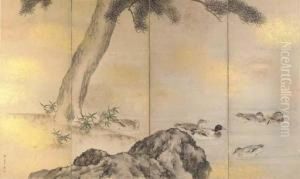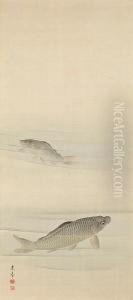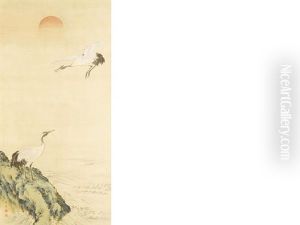Nakajima Raisho Paintings
Nakajima Raisho was a Japanese painter who lived during the late Edo period and into the Meiji Restoration. Born in Kyoto in 1796, Raisho was initially trained in the Maruyama-Shijo style of painting, which was known for its blend of Japanese subject matter with Western painting techniques and naturalistic detail. The Maruyama-Shijo school was founded by Maruyama Okyo and further developed by his student, Shijo Shonen, who emphasized observation from life in their artwork. This school of painting had a significant influence on Raisho's early development as an artist.
Raisho was particularly known for his landscape paintings, which exhibited a deep appreciation for the natural world. His works often depicted the beauty of the seasons with a quiet, poetic sensibility. He was skilled in both ink and color, and his landscapes are characterized by their serene and harmonious compositions. In addition to landscapes, Raisho also painted flowers, birds, and other subjects typical of the literati painting tradition, which stressed personal expression and scholarly learning.
Throughout his career, Raisho continued to evolve and adapt his style. He was influenced by Chinese literati painting (Nanga or Bunjinga in Japanese), which led him to incorporate more spontaneous and expressive brushwork into his paintings. This influence is particularly evident in his later works, which often embody the ideal of the literati painter as a cultured scholar and artist.
Raisho's contributions to Japanese art were recognized in his time, and he had a number of students who carried on his techniques and aesthetic values. Despite the political turmoil of the period, which saw the end of the shogunate and the restoration of the imperial rule, Raisho's art represents a continuity of traditional Japanese aesthetics, bridging the gap between the Edo and Meiji periods.
He passed away in 1871, leaving behind a legacy that influenced the development of Japanese landscape painting. His works continue to be appreciated for their lyrical beauty and are held in collections both in Japan and around the world.


